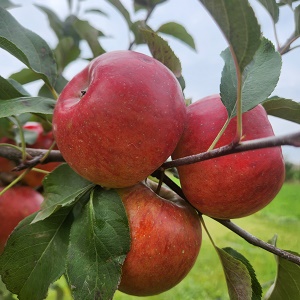Apple : SWEET SIXTEEN Semi-Dwarf (G969)
$53.95
Sweet Sixteen is superb eaten straight off the tree. It's delightfully complex combination of sweet, nutty, and spicy flavours have given rise to all sorts of comparisons. John Bunker of Fedco Nursery fame nailed it as good as any when he said it tastes like cherry Life Savers! Sweet Sixteen's crisp, cream-coloured, aromatic flesh will remind you of its Frostbite parent, while the large size and red striped appearance was imparted by its other parent - the venerable Northern Spy. Like the Spy it also ranks highly as a pie and sauce apple with respectable storage. Another hardy, dependable variety from the University of Minnesota showing some scab and fireblight resistance.
NEEDS A POLLENIZER | ZONE 3 | HARVEST: EARLY OCT.
Growing Tips
Besides selecting the most disease resistant varieties, there are
a few simple things to do to have better apples.
- Fertilize under the outer edges of your trees. There are no feeder roots next to the trunk. A well fed tree stays healthier. (Adequate calcium in the soil also helps so that apples keep longer.)
- Pick up fallen fruit and compost, dispose of, or feed to livestock (where possible).
- Rake up leaves in the fall and compost them away from the orchard.
- Prune trees to encourage light and air to reach the inside of the tree.
- Provide bird nesting sites near your orchard. A variety of orchard companion type plants will attract native pollinator insects and also encourage birds to come and eat insect pests.




